ANTARCTICA FEATURING THE
ROSS SEA
__________________
__________________
Step back into the Heroic Age of Antarctic Exploration to discover a wildlife wonderland. Departing Tasmania’s glorious south coast, sail to New Zealand’s Auckland and Enderby Islands to encounter sea lion harems and yellow-eyed penguins in the rata forests. While on Campbell Island, magnificent royal albatross court amidst megaherb meadows. Crossing the Antarctic Convergence, enter pack ice alive with orcas, seals and emperor penguins. On Cape Adare, the first documented landing site in Antarctica, be overwhelmed by the world’s largest Adélie penguin colony. Deep in the Ross Sea, the amazingly preserved huts of Scott and Shackleton await. Sail north, aiming for the remote Balleny Islands, then on to the tussocked coast of Macquarie Island, home to half a million king penguins and vast wallows of elephant seals. After a month away, the emerald shores of Tasmania greet you like a warm smile.
| Day | Place | Highlights |
|---|---|---|
| Day 1 | Tasmania, Australia | Arrive in Hobart, overnight in hotel |
| Day 2 | Tasmania, Australia | Embark on your voyage to the Ross Sea |
| Day 3-5 | At Sea | Relax on board as you settle into ship life |
| Day 6-7 | Auckland Islands | Enderby Island, Victoria Passage, Carnley Harbour |
| Day 8 | Campbell Island (Motu Ihupuku) | Witness various bird species and visit the seasonal research station |
| Day 9 - 12 | At Sea | Keep an eye out for passing wildlife |
| Day 13 | Cape Adare | Tip of the Ross Sea. Visit Borchgrevink's hut |
| Day 14 | Cape Hallett | Land near near abandoned research base and visit penguin colony |
| Day 15 | Terra Nova Bay | Visit the second largest emperor penguin colony if weather permits |
| Day 16 | McMurdo Sound | See the steam of Mt Erebus and visit some historic huts: Discovery Hut, Shackelton's Hut at Cape Royds and Cape Evans |
| Day 17-18 | Ross Sea, East Antarctica | Visit the Ross Ice Shelf and Ross Sea Coast |
| Day 19 | Balleny Islands | Attempt to reach the remote Balleny Islands a breeding habitat for seabirds and three seal species |
| Days 20-22 | At Sea | Relax onboard as you relive your memories throughout your time in Antarctica |
| Days 23 | Macquarie Island | Explore the only island in the world composed entirely of oceanic crust. Full of wildlife and natural beauty |
| Day 24-26 | At Sea | Relax onboard the ship, attend lectures by the expedition staff |
| Day 27 | Hobart, Australia | Disembark in Hobart before being transferred to your hotel or the airport |
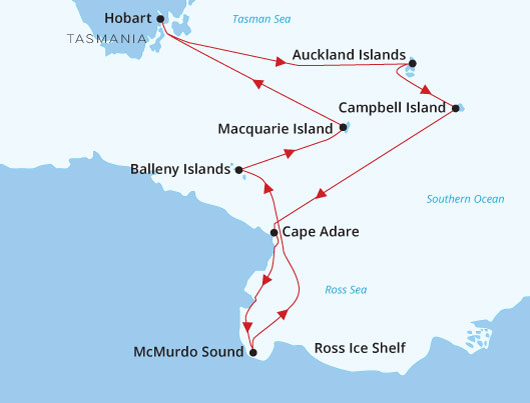
The Greg Mortimer commenced her first season in November 2019, she is purpose built, polar expedition vessel designed in close consultation with Antarctic expedition specialists and is the first expedition cruise ship designed with the ULSTEIN X-BOW hull. This cutting edge nautical technology allows for gentle travel and motion at sea, improved comfort and safety on-board, reduced vibrations, lower fuel consumption, lower air emissions and virtual anchoring which means the ship can float anchor-less while launching the Zodiacs without disturbing delicate sea floor areas. There are four sea-level launching platforms for fast and efficient access to and from Zodiacs.
Up to 132 guests are accommodated in staterooms all with en-suite facilities. The ship has custom-built hydraulic platforms offering guests unobstructed views, a dedicated activity platform and an indoor observation lounge with unobstructed panoramic views. The outdoor top deck allows for 360 degree views. The Greg Mortimer has set a new level in luxury and expedition cruising focusing on multiple landings, flexible itineraries and environmental sensitivity.
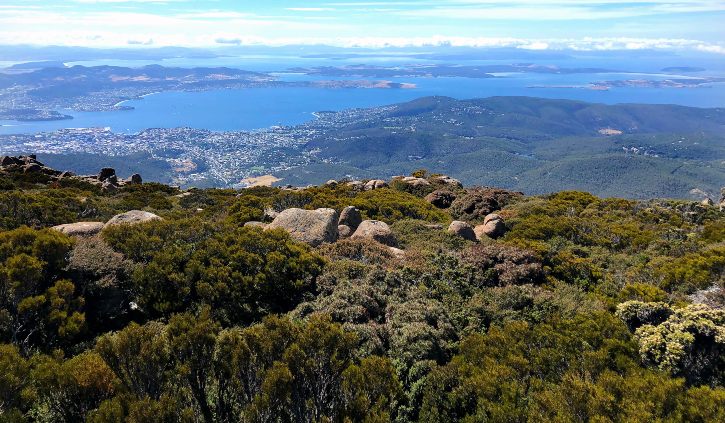
On arrival in Hobart you will be met and transferred to the group hotel Crowne Plaza Hobart. In the evening enjoy a light refreshment as you meet your fellow expeditioners then time at leisure to venture out for dinner (dinner not included).
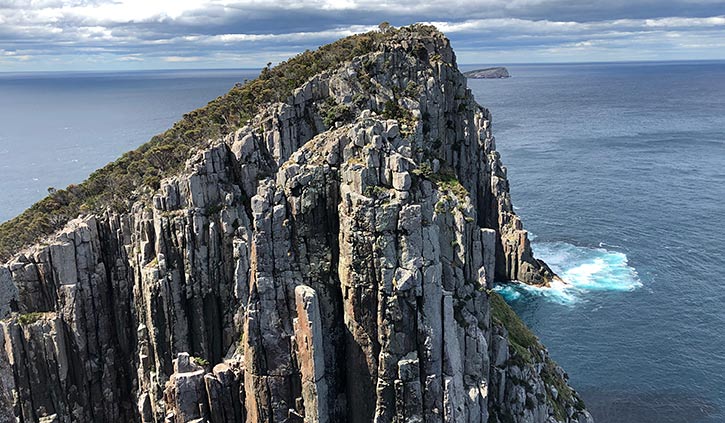
After breakfast enjoy a city tour (approx 2 hours) giving you insight into this historical city. In the afternoon board the Greg Mortimer. Enjoy a warm welcome by the crew then settle into your cabin and depart Hobart in the evening. Follow in the wake of Sir Douglas Mawson and the Australasian Antarctic Expedition of 1911, that also sailed down the Derwent River and into Storm Bay. After dinner, enjoy magnificent views of Cape Raoul’s striking dolerite cliffs on a ship’s cruise past Tasman Island.
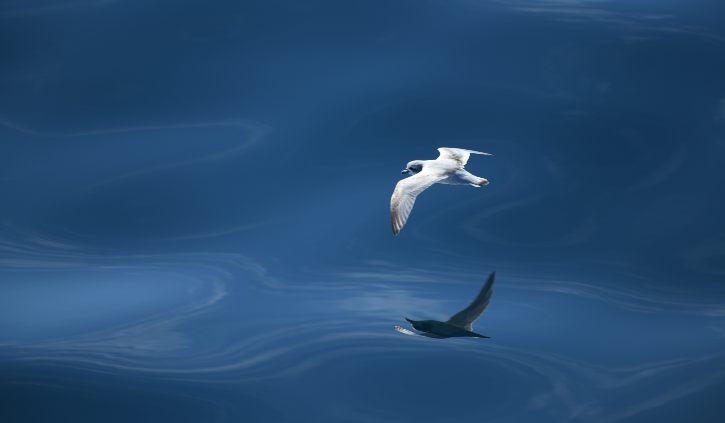
Enjoy exciting days at sea, with entertaining talks on exploration and natural history. Spend time on deck photographing seabirds and keeping an eye out for the rare sight of Campbell, Salvins and white-capped albatross, seen in few other regions.

First discovered in 1806 by British whaler Abraham Bristow, these remote specks of land in the Southern Ocean are a refuge for thousands of birds and sea lions. Depending on weather and sea conditions, Enderby Island, the most northern in the Auckland Islands, is our first landing. Hop aboard a Zodiac to cruise into Sandy Bay, land near a researcher’s hut, and be greeted by raucous New Zealand (Hooker’s) sea lions, the world’s rarest and most endangered of the five sea lion species. It’s breeding season, as 500-kilogram adult males fight for the favour of females, who form harems of up to 25 attended by a single dominant bull. Keep an eye out for newborn pups. Enter a forest fit for hobbits, walking among twisted trunks of southern rata trees. Stretch your legs on a hike across the island’s megaherb moors, spotting yellow-eyed penguins, light-mantled sooty albatross and royal albatross with a wingspan of nearly 3.5 metres. Our second day begins with an exciting Zodiac cruise through Victoria Passage, a lively channel separating Adams Island from Auckland Island (Motu Maha), and finishes with a walk into Erlangen Clearing, to hear of a German merchant ship that scavenged timber for its boilers hoping to escape to South America during World War II. After lunch, visit Carnley Harbour for superb Zodiac-cruising, and walks through rata forests alive with birdsong to historic sites from early sealers and World War II coastwatchers.
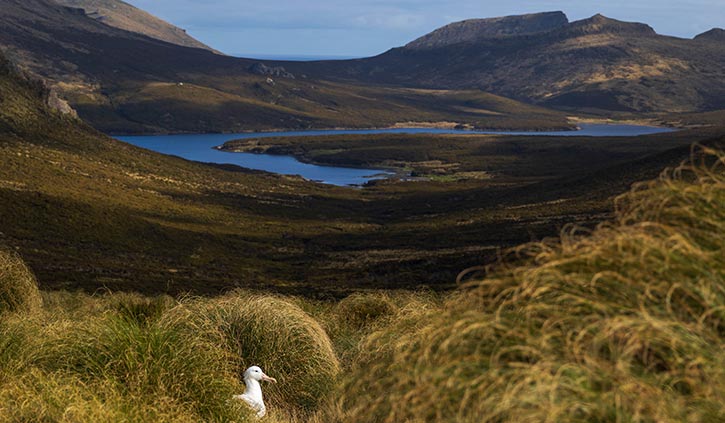
New Zealand’s most southerly subantarctic island is the highly eroded remnant of an ancient volcano that rises to 570 metres and cops some rough weather – gusts over 50 knots (96 kph) occur at least 100 days a year. After breakfast, Zodiac cruise protected Northeast Harbour to photograph waterfalls, yellow-eyed penguins and possibly the reintroduced endemic Campbell Island snipe. After lunch, land at the seasonal research station in Perseverance Harbour and hike up a boardwalk through flowering megaherb meadows to breeding southern royal albatross. Sit quietly and watch as they unfurl their three-metre wingspan, clack their beaks and issue their unforgettable, mournful cries.
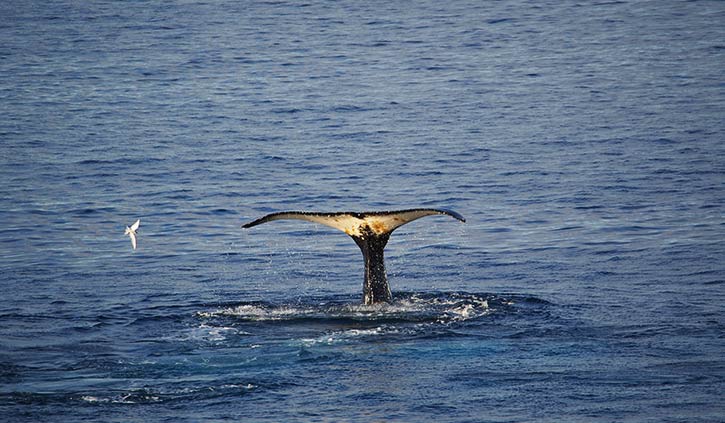
Marvel at the ULSTEIN X-BOW’s ability to smooth our ride as we sail the Southern Ocean, admiring wandering albatross in flight. Cross the Antarctic Convergence, where cold, dense polar waters meet temperate waters, hopefully heralding our first iceberg. Entering the ethereal world of pack ice, rejoice at how quickly the seas calm. Keep a watch for orcas, seals and penguins as we navigate a wonderland few have experienced.

Pent up excitement is palpable as we approach Cape Adare at the tip of the Ross Sea, home to Antarctica’s largest Adélie penguin colony and site of the first recorded landing in Antarctica. Ice and weather permitting, wend your way through ice-floes to land on the flat, cobbled spit shared by more than a million noisy penguins, many busy feeding chicks before joining the endless conveyor of adults moving to and from the sea. Treading carefully, we plan to make our way to Borchgrevink’s Hut, the oldest in Antarctica, where Norwegian/Australian Carsten Borchgrevink and his small team overwintered in 1899-1900. Step inside to inspect the interior and its artefacts and marvel at what it took to spend a dark winter here.
Set against the spectacular backdrop the wild Admiralty Mountains, Cape Hallett was the Antarctic foothold for the Australian Bicentennial Antarctic Expedition led by Aurora Expeditions founder (and ship’s namesake) Greg Mortimer. In 1988, Greg Mortimer and his team hauled sledges inland from here to climb 4263-m Mt Minto. If conditions permit, we plan to land near an abandoned American/New Zealand base to photograph the many Adélie penguins and Weddell seals on this breathtaking site.
Named after one of Robert Falcon Scott’s relief ships for his 1901-04 Discovery Expedition, Terra Nova Bay contains the remains of Drygalski Ice Tongue, what’s left after two massive icebergs sheared more than 200 sq km of ice from it in 2005 and 2006. We hope to visit the second largest emperor penguin colony in Antarctica at Cape Washington, and Inexpressible Island, where in 1912, Scott’s Northern Party dropped off six men for geological work over six weeks. Pack ice stopped their ship from returning and they spent a miserable winter in a 3.7 m x 2.7 m ice cave they excavated, living on the few seals and penguins they could find. In the Spring, they trekked 320 km around the coast to the main expedition party on Ross Island. Today Terra Nova Bay is home to the Italian base, Zucchelli, the Korean’s Jang Bogo Station, Germany’s Gondwana and under construction, China’s station, to be accessed by a blue ice runway.
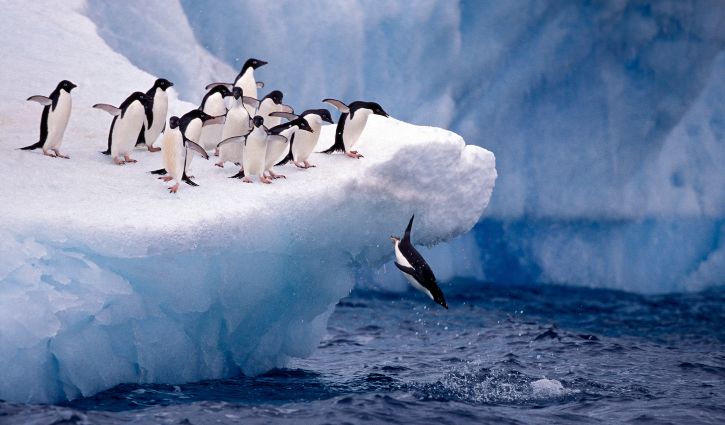
Welcome to the heart of Antarctica. If the ice permits, we enter a surreal world of exquisite beauty, where steam erupts from the 3,794 metre summit of Mt Erebus, the Transantarctic Mountains shimmer to the west, and the polar icecap wraps around Ross Island, home to Antarctica’s greatest monuments from the Heroic Age of Exploration. With a full day here, there are a number of options available to us depending on weather and sea ice conditions. Some of the remarkable historic monuments that we may visit include: Discovery Hut (Scott’s Nimrod expedition), Shackleton’s Hut at Cape Royds and Scott’s Hut (British Antarctic Expedition) at Cape Evans. Stand quietly amidst artefacts from these great expeditions then step outside to the busy world of Adélie penguins and Weddell seals. New Zealand’s Scott Base and the United States’ McMurdo Station, the largest scientific centre in Antarctica, housing up to 2,000 scientists in summer, are other fascinating research stations.
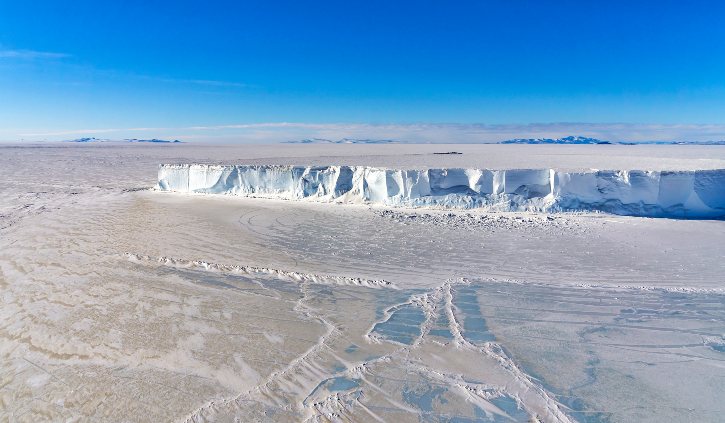
Sail along the perfectly cleaved ice cliffs of Antarctica’s largest ice shelf. Rising 30 metres from icy waters patrolled by pods of orca, the Ross Ice Shelf is about the size of France and the world’s largest body of floating ice. Watch for ethereal snow petrels as they play on air currents sweeping down from the polar ice cap.
Enjoy an exploration day, as we make our way back to the top of the Ross Sea. We may try landing on Franklin Island, with its vast Adélie penguin rookery and the chance to hike to the island’s summit. Or Zodiac-cruise the small rocky islets of Possession Islands; or simply pick a spot on the map to see what we can see.
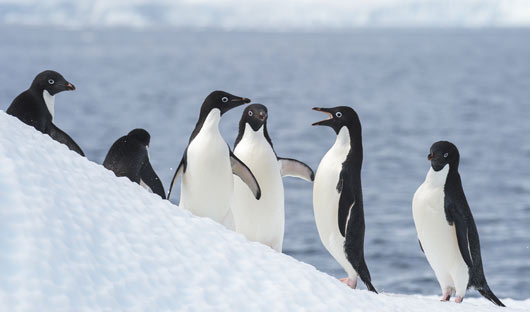
Attempt to reach the remote Balleny Islands, a 160-km chain of islands that provides resting and breeding habitat for seabirds and three seal species, yet few people have ever landed here. Volcanic in origin, some islands are still active. Elephant, leopard and crabeater seals have been identified in surrounding waters and Adélie penguins breed on shore. Simply seeing the islands would be a thrill, to Zodiac-cruise amongst them even better, a landing – the best. True expedition cruising.
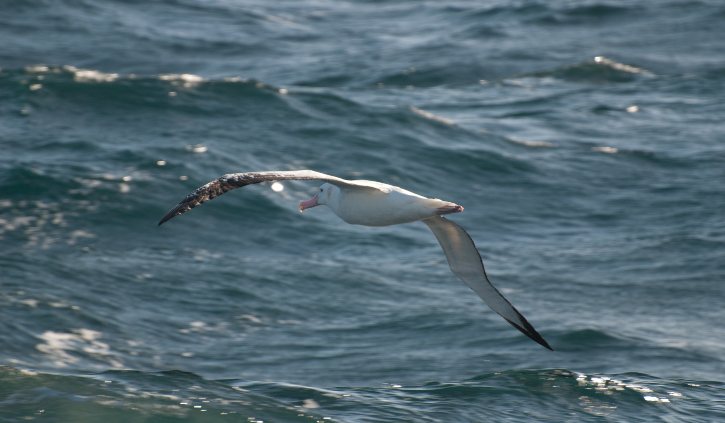
Spend the next few days at sea. You may wish to spend this time organising your vast collection of photographs or attending some lectures by the expedition team. Keep an eye out for any whales that might be cruising past.
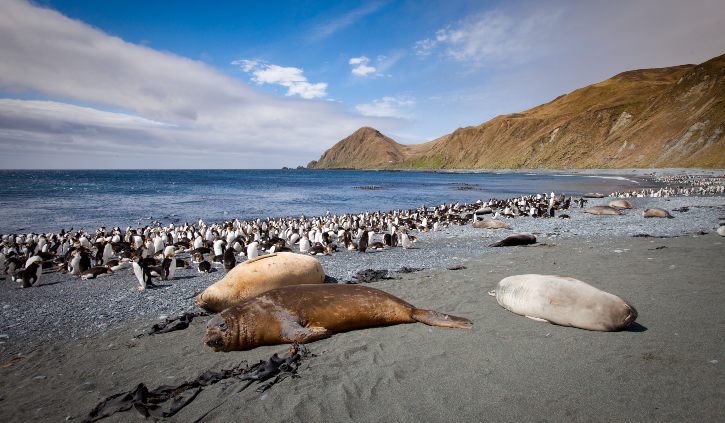
Douglas Mawson set up his communication base here in December 1911, and now supports one of the highest concentrations of wildlife in the Southern Ocean. Millions of penguins of four different species – king, rockhopper, gentoo and the endemic royal – breed here. Upon arrival, we hope to land at Sandy Bay, where a boardwalk leads up to a royal penguin rookery teeming with showy birds displaying their golden head feathers. At the shore are stately king penguins and chicks, and above fly black-browed and light-mantled sooty albatross. Fur and elephant seals hide amongst thick tussocks that have come back to life, thanks to a successful pest-eradication program.

Heading north, take time to assimilate the rich experiences of the past few weeks. Organise photo files, tidy up a journal or simply relax before stepping back into the ‘unreal’ world. As you approach Tasmania, breathe in the warmth and smells of the ‘Apple Isle’, a delight after almost a month away in the frozen latitudes. Like Mawson before us, we make our way into Storm Bay and up the Derwent to Hobart.

After breakfast, farewell your expedition team and disembark to be transferred to the airport or your hotel accommodation.